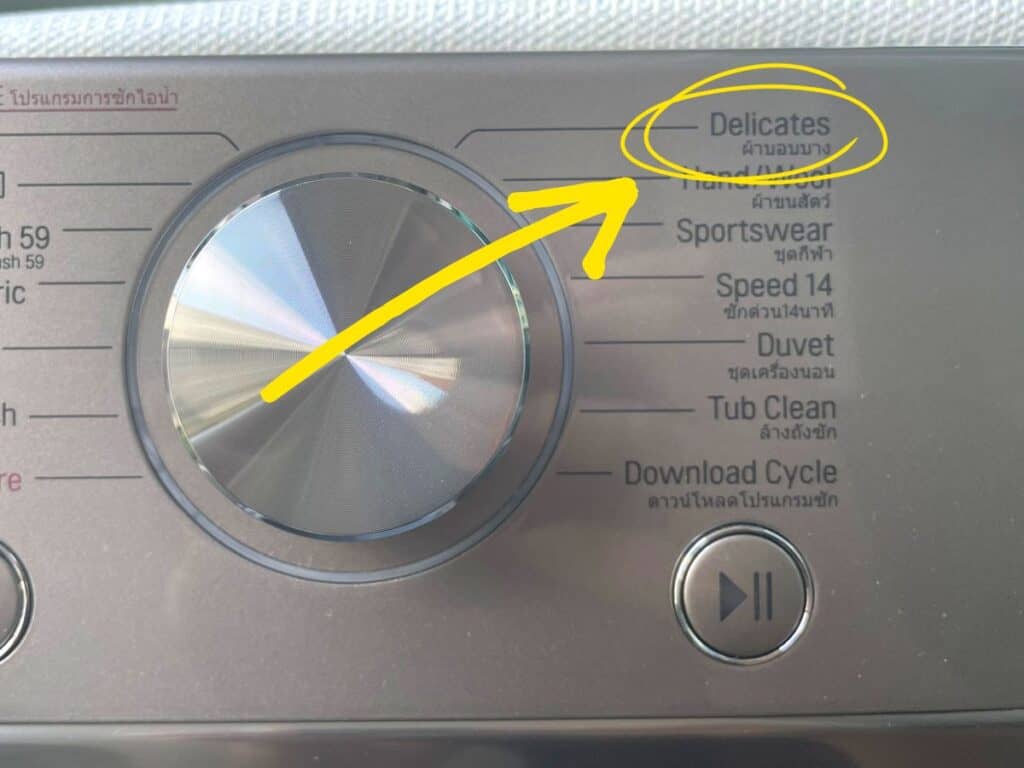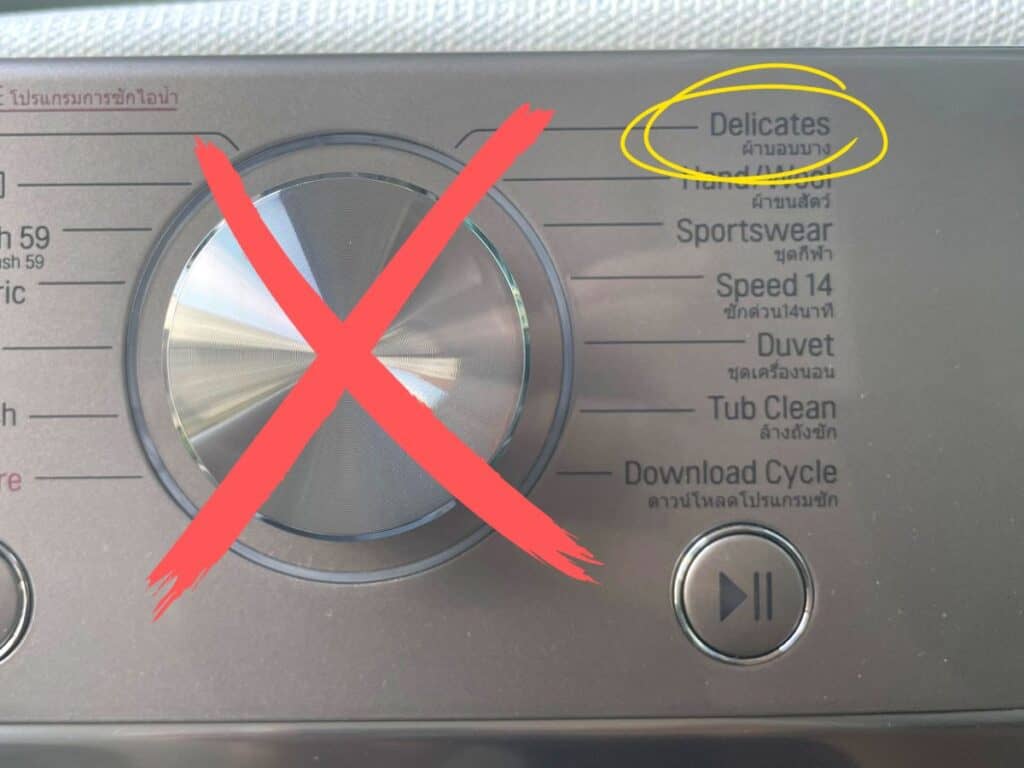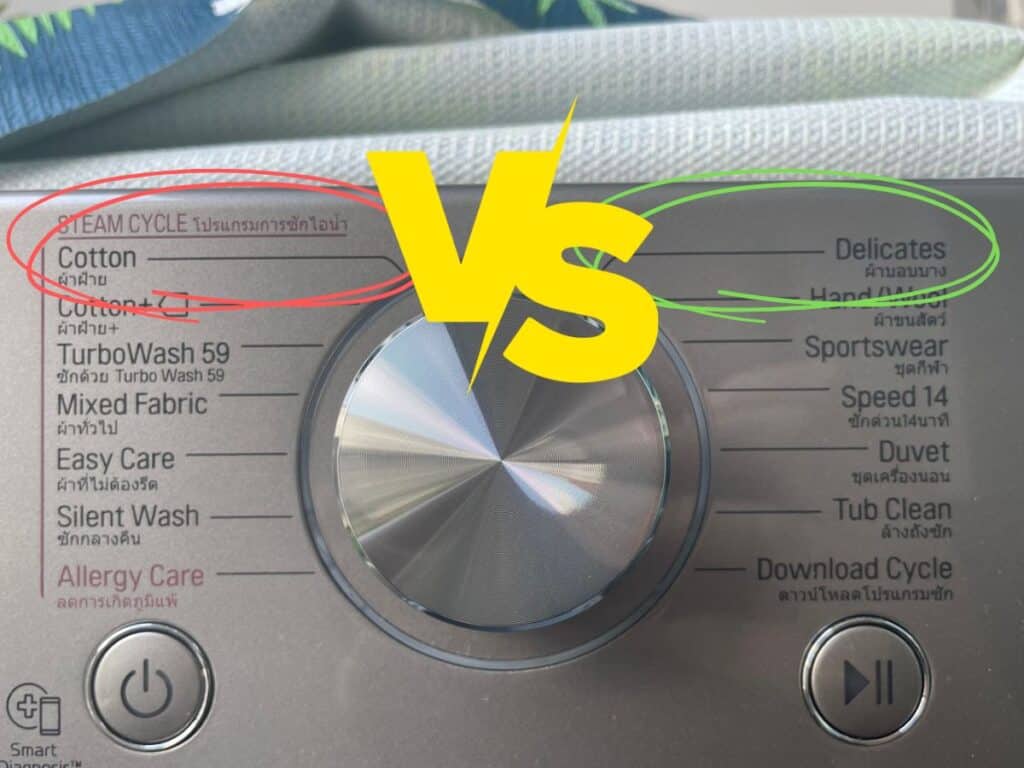As it often happens, your washer often comes with a ton of settings and features. Once you know how to operate it and get the laundry in and out of it, you tend to ignore the other settings and features.
But you could be missing out, especially when you have delicate and sensitive fabrics to wash.
The delicate wash is one of the gentlest cycles on the washer. It uses gentle agitation, low spin speed, and regular water temperatures to get delicate clothes washed in a short time. It also conserves water and energy, which reduces utility bills.
Most washers come with a delicate wash cycle pre-programmed in them. But what exactly does it do? And which clothes are considered delicates?
This article answers all these questions and shows you how to use the delicate wash cycle properly.
What is the Delicate Wash Cycle?
Suppose you have sensitive clothes that you’d rather wash by hand than put them through the rigorous washing cycles of the washer.
In that case, you’ll most likely benefit from the delicate wash cycle. It’s the washer’s definition of handwash.
During the delicate wash cycle, which doesn’t last long anyway, the washer will not heat the water.
Instead, it will use cold water to preserve the integrity and colors of the thin clothes. Once you’ve clicked the Start button, the washer refrains from its regular aggressive agitation.
It treats the laundry with gentle care.
With minimal water agitation, the fabrics don’t go through the usual rough and tumble that coarser fabrics are used to. Then the spin speed is also gentle.
There’s no risk of the laundry being slammed against the drum repeatedly to beat the stains out of it.
There’s no need for that.

And before you know it, the delicate wash cycle is over, and the laundry is ready to put out to dry. On average, the delicate wash cycle takes between 7 to 15 minutes, depending on the brand.
This short exposure to the detergent and fabric softener further protects the clothes against damage and color fading.
The only way I can think of that treats delicate clothes with so much care is if you wash them by hand.
But then again, why would you go through the trouble when you have this gentle cycle in the washer?
What Are Delicate Clothes?

So, we know what the delicate wash is all about.
But what exactly are delicate clothes?
And what makes a fabric delicate?
We need to answer these questions fully in order to make the most out of the delicate cycle and avoid any confusion as to what should go in the washer under this cycle and what shouldn’t.
First and foremost, the two distinguishing features of delicate clothes are the fabric types and the thinness of the material.
Delicates are often made of synthetic fabrics such as polyester, acrylic, and nylon, among others. These materials are thin and fragile by nature.
They repel water and stains and have little tolerance for the rough treatment of the wash tub.
Stockings, lingerie, hosiery, and undergarments, all fall under this category. They’re almost see-through and are too thin to retain moisture or stains.
But there are other factors that would make an item of clothing too sensitive or delicate for the regular wash cycle, even if it’s made of thick fabrics.
Some types of bras, for example, have metal wires in them to preserve their shape.
Such metal accessories make the item of clothing unsuitable for throwing in the washer under a normal wash cycle.
The wires are a risk for other clothes, and the rough agitation and high-speed spinning could cause tears and snags in the clothes.
Some natural fabrics are also considered delicate, such as silk. Although they wouldn’t tear easily, gentle washing is recommended to preserve the shape of the garment.
So, to sum up, let me outline what is considered delicate clothes in the following list.
- Silk, lace, and thin fabrics.
- Underwear of all types.
- Fabrics with colors that run.
- Wool fabrics, whether it’s natural wool or synthetic wool.
- Bras and corsets that have wires and metal accessories in them.
Just before we leave this section, I’d like to point out that hazardous materials such as color-running clothes and those with metal wires in them should be grouped in separate laundry bags to protect the other delicates in the load.
I’ve made a complete guide on how to use laundry bags that may interest you to read as well.
In fact, clothes with running colors should be washed separately.
Benefits of the Delicate Wash Cycle

I already hinted at some of the benefits of the delicate wash cycle, but for the sake of comprehensive coverage and in case you’re still not convinced you actually need this wash cycle in your washer at all, let me summarize the main benefits here.
The first benefit has to do with the tender loving care the washer shows the clothes under this setting.
Instead of the usual slam and agitate, the washer acts like a loving mother cradling the clothes and rocking them gently. This is as close as you can get to handwashing.
There’s little risk of snags or tearing when you wash your delicates under this setting. Even if some of the clothes have wires in them, by keeping them in a mesh bag, you’ll protect the other delicates.
The delicate wash cycle is fast. It averages between 7 to 15 minutes in total. That means less exposure to chemicals and less color fading.
The washer doesn’t heat up the water, which saves on energy. It also uses less water to wash and rinse thus reducing the water consumption with every cycle you use.
The result is drastically reduced water and electricity bills every month.
How to Wash Delicates
So how would you go about using the delicate wash cycle to ensure that the clothes are thoroughly clean?
To answer that, we have to start from the very beginning.
- Go through the hamper and separate the delicates from the other more hardy fabrics.
- Now go through the pile of delicates and separate them by type. The more delicate materials, such as lace underwear and hosiery, go in a separate pile—satins, cashmere, and silk materials in a separate pile, and so on.
- Sort out the items with metal wires in their own pile.
- Now put each pile of delicates in its own mesh bag and put it in the washer.
- If any of the delicates have tough stains on them, pre-treat the stains before washing them.
- Only fill the washer halfway. This is especially important if you have hazardous items with metal wires in them.
- Clothes that run color should be washed separately in their own load or with clothes of similar color.
- Use the gentlest laundry detergent you can find and use it according to the instructions on the package.
- Don’t add bleach or other stain removers.
- Check the tag on the clothes to see if a fabric softener is needed or not.
- Set the washer to the Delicate cycle and start the laundry.
- Come back after the cycle is finished to put out the laundry to dry.
- Don’t tumble dry. Air dry the clothes to protect them against the excessive spinning and heat of the dryer.
If you don’t have a gentle laundry detergent, here is a list of the best laundry detergents to use with delicates.
When Shouldn’t you Use Delicate Wash?

The nature of the fabric is the key factor in your decision whether to use the delicate wash cycle or whether another cycle is more appropriate.
Cotton and linen, for example, are hardy textiles that are not easy to clean in cold water. Such materials need heavy agitation and at least warm temperatures.
The same applies to denim, bedding, towels, and other heavy fabrics. Even more so if the clothes are heavily stained. So despite its many benefits, the delicate wash cycle is not ideal for all types of clothes.
At the same time, there are situations when you should use the delicate wash cycle even if the fabrics are thick.
For example, if you just bought a shirt or a pair of trousers and you’d want to wash it first before putting it on. The delicate wash cycle might be the fastest cycle in this situation.
But other than that, you should consider the Quick Wash and Normal cycles for the other clothes. Heavily stained clothes should be washed under the heavy-duty cycle and so on.
The Difference Between a Normal and a Delicate Cycle

The delicate cycle is very much different from the normal cycle.
If you only wash all your laundry in the normal cycle, there’s a good chance that your clothes will fade quickly. Not to mention the high utility bills every month.
But the main difference between the delicate cycle and the normal cycle can be outlined in the following.
- Water Temperature: The delicate cycle often uses cold water to protect the colors and synthetic fabrics that could damage easily. But a normal cycle would usually raise the water temperature up to 120 degrees F to improve the detergent’s ability to penetrate the fabrics and break down stains.
- Duration: The normal cycle takes anything from 60 to 90 minutes on average, depending on the brand and model of the washer. Compare that to the delicate cycle that only lasts between 7 to 15 minutes.
- Agitation: The normal wash cycle uses moderate to high water agitation to flush out stains and achieve good cleanliness levels. The delicate cycle only uses minimum agitation that rocks the clothes gently and sloshes the water here and there.
- Spinning Speed: While the normal cycle uses high speeds to spin the clothes during the wash, rinse, and dry cycles, the delicate cycle uses low spin speeds under 600 RPM. Moreover, the delicate cycle doesn’t spin the laundry dry.
- Water Consumption: On average, the normal cycle would fill the tub at least three times, the first time to wash and the other two for rinsing. The delicate cycle uses minimal water levels in comparison.
FAQs
Why Should You Air Dry Delicates?
Just as you would choose the delicate wash cycle to wash delicates for its gentle handling of the laundry, you wouldn’t want to tumble dry your delicate clothes.
The high speed of the dryer and the excessive temperatures could damage the sensitive fabrics and cause snags and tears.
Instead, it’s recommended that you air dry delicates. You’ll get better drying from the fresh air, and you won’t risk damaging them.
These thin fabrics tend to dry quickly, so even if you don’t have a sunny spot, just hanging them in the doorway should be enough to get them dry.
Which is Better, Hand Wash or Delicate Cycle?
The answer to that boils down to personal preferences and the time you have on your hands.
In general, handwashing even a single item of clothing, can take between 15 to 20 minutes if you want to do it properly. Not to mention the hassle of scrubbing and wrenching as much moisture as you can out of them.
The delicate cycle is the machine equivalent of handwashing. It takes the hassle out of it and delivers clean clothes in half the time.
So all things equal, I’d recommend using the delicate wash cycle with your delicate clothes.
How Long is a Delicate Wash Cycle?
The average time it takes for the washer to finish the delicate wash cycle varies depending on the brand and model of each washer.
Some washers will finish the cycle in as low as 7 minutes or less. Others might take up to 15 minutes to get the laundry done. And there are other washers that would take even longer than that.
Conclusion
The delicate wash cycle is for sensitive and delicate clothes that don’t need much water agitation or high spin speeds to get them cleaned out.
Such items as lace underwear, hosiery, and synthetic fabrics are considered delicates. The same goes for silk, satin, and cashmere materials.
The delicate cycle takes between 7 to 15 minutes to finish washing, and then you can air dry the laundry.
I’ve created a comprehensive guide on how to use all the settings on your washing machine that may interest you to read next.

I’m an expert wardrobe organizer and a bit of a clean freak. I created this website and its YouTube channel to share practical guides about laundry and organizing. My teachings have been featured in multiple large news publications, and I’ve self-published two wardrobe organizing books and an entire course on the subject.

